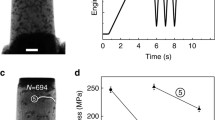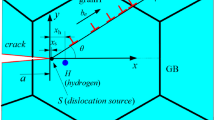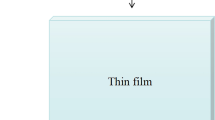Abstract
The hydrogen effect on the nucleation and motion of dislocations in single-crystal bcc Fe with (110) surface was investigated by both nanoindentation experiments and discrete dislocation dynamics (DDD) simulation. The results of nanoindentation experiments showed that the pop-in load decreased evidently for the electrochemical hydrogen charging specimen, indicating that the dislocation nucleation strength might be reduced by hydrogen. In addition, the decrease of hardness due to hydrogen charging was also captured, implying that the dislocation motion might be promoted by hydrogen. By incorporating the effect of hydrogen on dislocation core energy, a DDD model was specifically proposed to investigate the influence of hydrogen on dislocation nucleation and motion. The results of DDD simulation revealed that under the effect of hydrogen, the dislocation nucleation strength is decreased and the motion of dislocation is promoted.





Similar content being viewed by others
References
Robertson IM, Sofronis P, Nagao A, Martin ML, Wang S, Gross DW, Nygren KE. Hydrogen embrittlement understood. Metall Mater Trans A Phys Metall Mater Sci. 2015;46:2323–41. https://doi.org/10.1007/s11661-015-2836-1.
Robertson IM. The effect of hydrogen on dislocation dynamics. Eng Fract Mech. 1999;68:671–92. https://doi.org/10.1016/S0013-7944(01)00011-X.
Hirth JP. Effects of hydrogen on the properties of iron and steel. Metall Trans A. 1980;11:861–90. https://doi.org/10.1007/BF02654700.
Nagumo M. Function of hydrogen in embrittlement of high-strength steels. ISIJ Int. 2001;41:590–8. https://doi.org/10.2355/isijinternational.41.590.
Birnbaum HK, Sofronis P. Hydrogen-enhanced localized plasticity-a mechanism for hydrogen-related fracture. Mater Sci Eng A. 1994;176:191–202. https://doi.org/10.1016/0921-5093(94)90975-X.
John CS, Gerberich WW. Effect of loading mode on hydrogen embrittlement. Met Trans. 1973;4:589–94. https://doi.org/10.1007/BF02648714.
Jang WK, Kim SS, Shin KS. Effect of cathodic hydrogen charging on mechanical properties of Al 8090. Scr Mater. 1999;40:503–8. https://doi.org/10.1016/S1359-6462(98)00472-2.
Smith GC, Wasserstoff D. The influence of hydrogen on the plastic deformation ductility, and fracture of nickel in tension. Acta Metall. 1963;11:165–78.
Abraham DP, Altstetter CJ. The effect of hydrogen on the yield and flow stress of an austenitic stainless steel. Metall Mater Trans A. 1995;26:2849–58. https://doi.org/10.1007/BF02669643.
Matsui H, Kimura H, Kimura A. The effect of hydrogen on the mechanical properties of high purity iron III. The dependence of softening in specimen size and charging current density. Mater Sci Eng. 1979;40:227–34. https://doi.org/10.1016/0025-5416(79)90193-9.
Matsui H, Kimura H, Moriya S. The effect of hydrogen on the mechanical properties of high purity iron I. Softening and hardening of high purity iron by hydrogen charging during tensile deformation. Mater Sci Eng. 1979;40:207–16. https://doi.org/10.1016/0025-5416(79)90191-5.
Barnoush A, Vehoff A. Recent developments in the study of hydrogen embrittlement: Hydrogen effect on dislocation nucleation. Acta Mater. 2010;58:5274–85. https://doi.org/10.1016/j.actamat.2010.05.057.
Kheradmand N, Dake J, Barnoush A, Vehoff H. Novel methods for micromechanical examination of hydrogen and grain boundary effects on dislocations. Philos Mag. 2012;92:3216–30. https://doi.org/10.1080/14786435.2012.690939.
Rogne BRS, Kheradmand N, Deng Y, Barnoush A. In situ micromechanical testing in environmental scanning electron microscope: A new insight into hydrogen-assisted cracking. Acta Mater. 2018;144:257–68. https://doi.org/10.1016/j.actamat.2017.10.037.
Deutges M, Knorr I, Borchers C, Volkert CA, Kirchheim R. Influence of hydrogen on the deformation morphology of vanadium (1 0 0) micropillars in the \(\alpha \)-phase of the vanadium-hydrogen system. Scr Mater. 2013;68:71–4. https://doi.org/10.1016/j.scriptamat.2012.09.020.
Chen YZ, Barth YP, Deutges M, BorchersC Liu F, Kirchheim R. Increase in dislocation density in cold-deformed Pd using H as a temporary alloying addition. Scr Mater. 2013;68:743–6. https://doi.org/10.1016/j.scriptamat.2013.01.005.
Zhao Y, Seok MY, Choi IC, Lee YH, Park SJ, Ramamurty U, Suh JY, Jang J. The role of hydrogen in hardening/softening steel: Influence of the charging process. Scr Mater. 2015;107:46–9. https://doi.org/10.1016/j.scriptamat.2015.05.017.
Barnoush A, Asgari M, Johnsen R. Resolving the hydrogen effect on dislocation nucleation and mobility by electrochemical nanoindentation. Scr Mater. 2012;66:414–7. https://doi.org/10.1016/j.scriptamat.2011.12.004.
Barnoush A, Dake J, Kheradmand N, Vehoff H. Examination of hydrogen embrittlement in FeAl by means of in situ electrochemical micropillar compression and nanoindentation techniques. Intermetallics. 2010;18:1385–9. https://doi.org/10.1016/j.intermet.2010.01.001.
Barnoush A, Kheradmand N, Hajilou T. Correlation between the hydrogen chemical potential and pop-in load during in situ electrochemical nanoindentation. Scr Mater. 2015;108:76–9. https://doi.org/10.1016/j.scriptamat.2015.06.021.
Cottrell AH, Bilby BA. Dislocation theory of yielding and strain ageing of iron. Proc Phys Soc Sect A. 1949;62:49–62. https://doi.org/10.1088/0370-1298/62/1/308.
Xie D, Li S, Li M, Wang Z, GumbschP Sun J, Ma E, Li J, Shan Z. Hydrogenated vacancies lock dislocations in aluminium. Nat Commun. 2016;7:1–7. https://doi.org/10.1038/ncomms13341.
Song J, Curtin WA. Mechanisms of hydrogen-enhanced localized plasticity: An atomistic study using \(\alpha \)-Fe as a model system. Acta Mater. 2014;68:61–9. https://doi.org/10.1016/j.actamat.2014.01.008.
Ferreira PJ, Robertson IM, Birnbaum HK. Hydrogen effects on the interaction between dislocations. Acta Mater. 1998;46:1749–57. https://doi.org/10.1016/S1359-6454(97)00349-2.
Sills RB, Cai W. Free energy change of a dislocation due to a Cottrell atmosphere. Philos Mag. 2018;98:1491–510. https://doi.org/10.1080/14786435.2018.1441560.
Zhu YX, Li ZH, Huang MS, Fan HD. Study on interactions of an edge dislocation with vacancy-H complex by atomistic modelling. Int J Plast. 2017;92:31–44. https://doi.org/10.1016/j.ijplas.2017.03.003.
Wang S, Hashimoto N, Ohnuki S. Hydrogen-induced change in core structures of 110 [111] edge and 110 [111] screw dislocations in iron. Sci Rep. 2013;3:10–3. https://doi.org/10.1038/srep02760.
Lu G, Zhang Q, Kioussis N, Kaxiras E. Hydrogen-enhanced local plasticity in aluminum: An ab initio study. Phys Rev Lett. 2001;87:955011–4. https://doi.org/10.1103/PhysRevLett.87.095501.
Katzarov IH, Pashov DL, Paxton AT. Hydrogen embrittlement I Analysis of hydrogen-enhanced localized plasticity: Effect of hydrogen on the velocity of screw dislocations in \(\alpha \) -Fe. Phys Rev Mater. 2017;1:033602. https://doi.org/10.1103/PhysRevMaterials.1.033602.
Barnoush A, Bies C, Vehoff H. In situ electrochemical nanoindentation of FeAl (100) single crystal: Hydrogen effect on dislocation nucleation. J Mater Res. 2009;24:1105–13. https://doi.org/10.1557/jmr.2009.0084.
Zhao Y, Choi IC, Seok MY, Ramamurty U, Suh JY, Jang J. Hydrogen-induced hardening and softening of Ni-Nb-Zr amorphous alloys: Dependence on the Zr content. Scr Mater. 2014;93:56–9. https://doi.org/10.1016/j.scriptamat.2014.08.029.
Lu X, Ma Y, Zamanzade M, Deng Y, Wang D, Bleck W, Song WW, Barnoush A. Insight into hydrogen effect on a duplex medium-Mn steel revealed by in-situ nanoindentation test. Int J Hydrogen Energy. 2019;44:20545–51. https://doi.org/10.1016/j.ijhydene.2019.04.290.
Lee DH, Lee JA, Seok MY, Baek UB, Nahm SH, Jang J. Stress-dependent hardening-to-softening transition of hydrogen effects in nanoindentation of a linepipe steel. Int J Hydrogen Energy. 2014;39:1897–902. https://doi.org/10.1016/j.ijhydene.2013.11.060.
Ayas C, Van Dommelen JAW, Deshpande VS. Climb-enabled discrete dislocation plasticity. J Mech Phys Solids. 2014;62:113–36. https://doi.org/10.1016/j.jmps.2013.09.019.
Keralavarma SM, Benzerga AA. High-temperature discrete dislocation plasticity. J Mech Phys Solids. 2015;82:1–22. https://doi.org/10.1016/j.jmps.2015.05.003.
Wang J, Huang M, Zhu Y, Liang S, Li Z. Vacancy diffusion coupled discrete dislocation dynamic modeling of compression creep of micro-pillars at elevated temperature. Int J Solids Struct. 2020;193–194:375–92. https://doi.org/10.1016/j.ijsolstr.2020.02.024.
Li Z, Hou C, Huang M, Ouyang C. Strengthening mechanism in micro-polycrystals with penetrable grain boundaries by discrete dislocation dynamics simulation and Hall-Petch effect. Comput Mater Sci. 2009;46:1124–34. https://doi.org/10.1016/j.commatsci.2009.05.021.
Huang M, Li Z, Tong J. The influence of dislocation climb on the mechanical behavior of polycrystals and grain size effect at elevated temperature. Int J Plast. 2014;61:112–27. https://doi.org/10.1016/j.ijplas.2014.06.002.
Quek SS, Wu Z, Zhang YW, Srolovitz DJ. Polycrystal deformation in a discrete dislocation dynamics framework. Acta Mater. 2014;75:92–105. https://doi.org/10.1016/j.actamat.2014.04.063.
Wei DA, Zaiser M, Feng Z, Kang G, Fan H, Zhang X. Effects of twin boundary orientation on plasticity of bicrystalline copper micropillars: A discrete dislocation dynamics simulation study. Acta Mater. 2019;176:289–96. https://doi.org/10.1016/j.actamat.2019.07.007.
Fan H, Aubry S, Arsenlis A, El-Awady JA. The role of twinning deformation on the hardening response of polycrystalline magnesium from discrete dislocation dynamics simulations. Acta Mater. 2015;92:126–39. https://doi.org/10.1016/j.actamat.2015.03.039.
Bertin N, Sills RB, Cai W. Frontiers in the Simulation of Dislocations. Annu Rev Mater Res. 2020;50:437–64. https://doi.org/10.1146/annurev-matsci-091819-015500.
Huang Tong J, Li Z. A study of fatigue crack tip characteristics using discrete dislocation dynamics. Int J Plast. 2014;54:229–46. https://doi.org/10.1016/j.ijplas.2013.08.016.
Liang S, Zhu Y, Huang M, Li Z. Studying dislocation-induced shielding effect on the crack-tip in polycrystal by discrete dislocation dynamics. Int J Solids Struct. 2019;156–157:148–62. https://doi.org/10.1016/j.ijsolstr.2018.08.012.
Liang S, Zhu Y, Huang M, Li Z. Simulation on crack propagation vs. crack-tip dislocation emission by XFEM-based DDD scheme. Int J Plast. 2019;114:87–105. https://doi.org/10.1016/j.ijplas.2018.10.010.
Huang M, Li Z. The key role of dislocation dissociation in the plastic behaviour of single crystal nickel-based superalloy with low stacking fault energy: Three-dimensional discrete dislocation dynamics modelling. J Mech Phys Solids. 2013;61:2454–72. https://doi.org/10.1016/j.jmps.2013.07.011.
Huang S, Huang M, Li Z. Effect of interfacial dislocation networks on the evolution of matrix dislocations in nickel-based superalloy. Int J Plast. 2018;110:1–18. https://doi.org/10.1016/j.ijplas.2018.06.005.
Gu Y, El-Awady JA. Quantifying the effect of hydrogen on dislocation dynamics: A three-dimensional discrete dislocation dynamics framework. J Mech Phys Solids. 2018;112:491–507. https://doi.org/10.1016/j.jmps.2018.01.006.
Yu H, Cocks A, Tarleton E. Discrete dislocation plasticity HELPs understand hydrogen effects in bcc materials. J Mech Phys Solids. 2019;123:41–60. https://doi.org/10.1016/j.jmps.2018.08.020.
Nix WD, Gao H. Indentation size effects in crystalline materials: A law for strain gradient plasticity. J Mech Phys Solids. 1998;46:411–25. https://doi.org/10.1016/S0022-5096(97)00086-0.
Feng G, Nix WD. Indentation size effect in MgO. Scr Mater. 2004;51:599–603. https://doi.org/10.1016/j.scriptamat.2004.05.034.
Durst K, Backes B, Göken M. Indentation size effect in metallic materials: Correcting for the size of the plastic zone. Scr Mater. 2005;52:1093–7. https://doi.org/10.1016/j.scriptamat.2005.02.009.
Liu W, Chen L, Cheng L, Yu L, Yi X, Gao H, Duan H. Model of nanoindentation size effect incorporating the role of elastic deformation. J Mech Phys Solids. 2019;126:245–55. https://doi.org/10.1016/j.jmps.2019.02.015.
Hirth JP, Lothe J. Theory of Dislocations. 1968.
Yu H, Katzarov IH, Paxton AT, Cocks ACF, Tarleton E. Influence of hydrogen core force shielding on dislocation junctions in iron. Phys Rev Mater. 2020;4:1–16. https://doi.org/10.1103/PhysRevMaterials.4.033607.
Kimizuka H, Ogata S. Slow diffusion of hydrogen at a screw dislocation core in \(\alpha \)-iron. Phys Rev B - Condens Matter Mater Phys. 2011;84:1–6. https://doi.org/10.1103/PhysRevB.84.024116.
Itakura M, Kaburaki H, Yamaguchi M, Okita T. The effect of hydrogen atoms on the screw dislocation mobility in bcc iron: A first-principles study. Acta Mater. 2013;61:6857–67. https://doi.org/10.1016/j.actamat.2013.07.064.
Clouet E. Elastic energy of a straight dislocation and contribution from core tractions. Philos Mag. 2009;89:1565–84. https://doi.org/10.1080/14786430902976794.
Clouet E, Ventelon L, Willaime F. Dislocation core energies and core fields from first principles. Phys Rev Lett. 2009;102:1–4. https://doi.org/10.1103/PhysRevLett.102.055502.
Hu Y, Szajewski BA, Rodney D, Curtin WA. Atomistic dislocation core energies and calibration of non-singular discrete dislocation dynamics. Model Simul Mater Sci Eng. 2020;28. https://doi.org/10.1088/1361-651X/ab5489.
Cai W, Arsenlis A, Weinberger CR, Bulatov VV. A non-singular continuum theory of dislocations. J Mech Phys Solids. 2006;54:561–87. https://doi.org/10.1016/j.jmps.2005.09.005.
Arsenlis A, Cai W, Tang M, Rhee M, Oppelstrup T, Hommes G, Pierce TG, Bulatov VV. Enabling strain hardening simulations with dislocation dynamics. Model Simul Mater Sci Eng. 2007;15:553–95. https://doi.org/10.1088/0965-0393/15/6/001.
Yu H, Cocks ACF, Tarleton E. Simulating hydrogen in fcc materials with discrete dislocation plasticity. Int J Hydrogen Energy. 2020; 1–13. https://doi.org/10.1016/j.ijhydene.2020.01.118.
Acknowledgements
This work was financially supported by the National Natural Science Foundation of China (Grant Nos. 11632007 and 11802099).
Author information
Authors and Affiliations
Corresponding authors
Appendix A
Appendix A
The interaction between two dislocation segments with different core widths a and b is derived here. In the non-singular dislocation theory, the distribution of the Burgers vector is isotropic, which is formulated as [61]:
where \({\varvec{g}}\left( {{\varvec{x}}} \right) ={\varvec{b}}\tilde{{w}}_{a} \left( {{\varvec{x}}} \right) ={\varvec{b}}\tilde{{w}}_{a} \left( r \right) \) is the Burgers vector density function, and \(\tilde{{w}}\left( r \right) \) is the Burgers vector distribution function within the dislocation core width a. \(w_{a} \left( x \right) \) is defined as the convolution of \(\tilde{{w}}_{a} \left( {{\varvec{x}}} \right) \) with itself. Under the assumption that \(R_{a} \left( {{\varvec{x}}} \right) =R\left( {{\varvec{x}}} \right) *w_{a} \left( {{\varvec{x}}} \right) =\sqrt{R\left( {{\varvec{x}}} \right) ^{2}+a^{2}} \), \(w_{a} \left( {{\varvec{x}}} \right) \) can be derived as:
where \(R\left( {{\varvec{x}}} \right) =\sqrt{x^{2}+y^{2}+z^{2}} \). For a dislocation loop with the isotropic distribution \(g\left( {{\varvec{x}}} \right) \), its stress fields can be expressed as:
where \({\varvec{A}}_{\alpha \beta ijklm} \) is the elastic tensor. For a dislocation with Burgers vector distribution \(\tilde{{w}}\left( r \right) \), the stress acting on another dislocation with the same Burgers vector distribution is:
Since \(R_{a} =R\left( {{\varvec{x}}} \right) *\tilde{{w}}{ }_{a}\left( {{\varvec{x}}} \right) *\tilde{{w}}_{a} \left( {{\varvec{x}}} \right) \) is obtained by the second convolution of \(R_{a} \) and \(\tilde{{w}}\left( {{\varvec{x}}} \right) \), the stress field \(\mathbf {\sigma }_{\alpha \beta } \left( {{\varvec{x}}} \right) \) can be obtained analytically and used to calculate the interaction stress between two dislocations with the same core width a. However, because the convolution \(R_{ab} =R\left( {{\varvec{x}}} \right) *w{ }_{a}\left( {\mathbf {x}} \right) *w_{b} \left( {{\varvec{x}}} \right) \) does not have an analytical expression, the interaction stress between two dislocations with different core widths a and b cannot be obtained analytically. Therefore, how to obtain the interaction force between two dislocation segments with different core widths a and b is transformed into a mathematical problem to determine the convolution of \(\tilde{{w}}{ }_{a}\left( {{\varvec{x}}} \right) *\tilde{{w}}_{b} \left( {{\varvec{x}}} \right) \).
According to the convolution theorem, the Fourier transform of a convolution of two functions is the product of their Fourier transforms:
where \(K_{2} \left( {a\omega } \right) \) and \(K_{2} \left( {b\omega } \right) \) are the Bessel functions of the second kind. The numerical solution of \(\tilde{{w}}{ }_{a}\left( {{\varvec{x}}} \right) *\tilde{{w}}_{b} \left( {{\varvec{x}}} \right) \) can be obtained by performing the inverse Fourier transform in Eq. (A5). However, in the DDD simulation, it is intractable to compute the numerical solution \(\tilde{{w}}{ }_{a}\left( {{\varvec{x}}} \right) *\tilde{{w}}_{b} \left( {{\varvec{x}}} \right) \) for every two dislocation segments in every time step, and thus an approximate analytical solution \(w_{c} \left( {{\varvec{x}}} \right) \approx \tilde{{w}}{ }_{a}\left( {{\varvec{x}}} \right) *\tilde{{w}}_{b} \left( {{\varvec{x}}} \right) \) is adopted here. In other words, the convolution of \(\tilde{{w}}{ }_{a}\left( {{\varvec{x}}} \right) *\tilde{{w}}_{b} \left( {{\varvec{x}}} \right) \) is replaced by the convolution of \(\tilde{{w}}{ }_{c}\left( {{\varvec{x}}} \right) *\tilde{{w}}_{c} \left( {{\varvec{x}}} \right) \). This means the interaction force between two dislocation segments with core widths a and b is replaced by the interaction force between two dislocation segments with the same core width c. The value of c is assumed to be the function \(c=f\left( {a,b} \right) \), which is fitted with the numerical solution of \(\tilde{{w}}{ }_{a}\left( {{\varvec{x}}} \right) *\tilde{{w}}_{b} \left( {{\varvec{x}}} \right) \) in the range \(0.5\le \gamma \le 0.99\) with \(\gamma \text{= }\min \left( {a,b} \right) /\max \left( {a,b} \right) \).
The numerical solution of \(\tilde{{w}}{ }_{a}\left( r \right) *\tilde{{w}}_{b} \left( r \right) \) and the approximate analytical solution \(w_{c} \left( r \right) \) with \(\gamma =0.5\) are compared in Fig. 6, which shows that \(w_{c} \left( r \right) \) is in good agreement with the numerical solution of \(\tilde{{w}}{ }_{a}\left( r \right) *\tilde{{w}}_{b} \left( r \right) \). According to the method above, the function \(c=f\left( {a,b} \right) \) can be obtained as:
where \(P_{1} =0.1462\), \(P_{2} =0.2191\) and \(P_{3} =0.6352\) are the fitting parameters. After c is determined, the interaction stress between two dislocations with different core widths a and b can be calculated by Eq. (A4) with \(R_{a} \) replaced by \(R_{c} \).
Rights and permissions
About this article
Cite this article
Wang, J., Zhao, L., Huang, M. et al. Effect of Hydrogen on Dislocation Nucleation and Motion: Nanoindentation Experiment and Discrete Dislocation Dynamics Simulation. Acta Mech. Solida Sin. 35, 1–14 (2022). https://doi.org/10.1007/s10338-021-00261-9
Received:
Revised:
Accepted:
Published:
Issue Date:
DOI: https://doi.org/10.1007/s10338-021-00261-9





